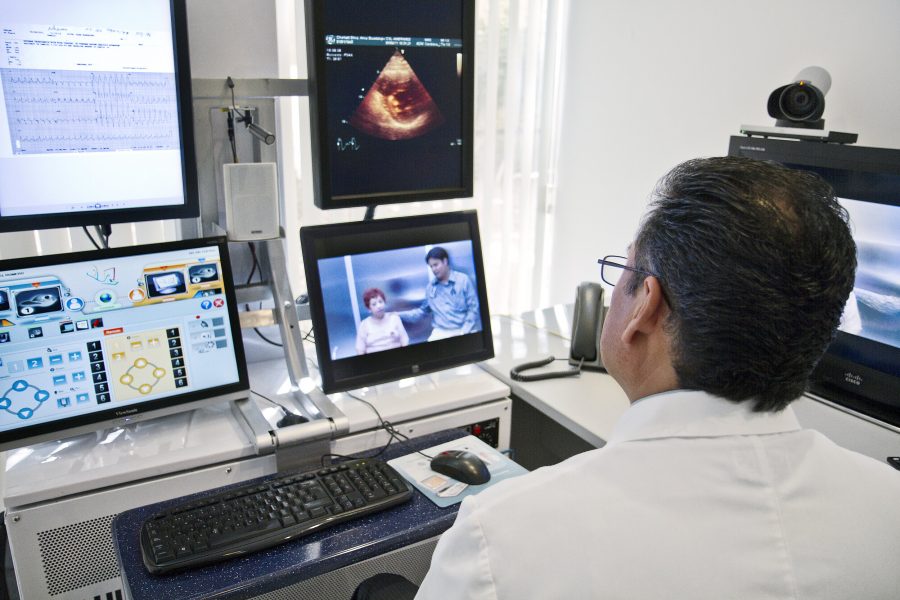The Rise of Telemedicine in the United States to Combat COVID-19
Courtesy of Wikimedia Commons
April 7, 2020
Telemedicine appears to be the solution to the current lack of resources. It is already used in developing countries around the world as a means of speaking to health professionals who have access to each individual’s health records online.
Now, in the United States, telemedicine in the form of Zoom video calls with patients allows a more immediate response to patients, and for thousands to be seen a day. It also allows health professionals and patients to remain in their homes and away from others who do have the virus. Telemedicine will aid in decreasing the likelihood of the coronavirus spreading.
In fact, the usage of this method is supported by medical professionals as well as the government.
“Telemedicine got an additional boost under the $8.3 billion emergency funding measure from Congress, which loosened restrictions on its use to treat people covered under the federal Medicare program,” according to The New York Times.
If proven to be successful during this pandemic, telemedicine could be further expanded in the United States. Forbes details how this technological shift could spur a medical upend:
Firstly, the United States could adapt The Internet of Medical Things. This website takes patient’s data and stores it so a licensed medical professional can view their history in real time and give a more accurate diagnosis.
For example, a patient previously told to wear a pacemaker could have it connected to another device like a phone or computer and alerts the designated health professional that something is wrong. This technology actually already exists and is up to par with the health industry’s standards and regulation. It has been used by other countries, especially in Europe, but is yet to be adapted to the United States health industry.
Secondly, as artificial intelligence becomes more mainstream, it will have the ability to scan through cases of patients with similar health conditions without breaching patients’ privacy. Then, telemedicine would be able to also give faster diagnoses.
Virtual reality could also be adapted into the telemedicine field. Doctors would be able to use “MRG (Mixed Reality Glasses” which would allow them to be anywhere in the United States, but still see a patient as though they are in front of them.
Lastly, “In the future, an implant that will be inserted under the skin and will monitor a patient’s vital signs. With this technology, the patient’s temperature, blood pressure, heart rate, blood oxygen, and glucose can be measured on a minute-by-minute basis.” Though this technology is not fully developed yet and is the most controversial, it would again allow doctors to operate at maximum efficiency.
These advances in technology would allow needed medical advice and help to be more accessible and come at a faster rate. Yes, telemedicine seems to be beneficial, but it also has its limitations.
The New York Times highlighted one of the major setbacks of telemedicine.
‘“We’re being very explicit at Zoom+Care that we can’t test you for Covid-19,” said Dr. Mark Zeitzer, who is the [Zoom+Care] clinics’ medical director of acute care services. Instead, people may be told to self-quarantine and keep a careful eye on their symptoms.”
Evidently, though doctors are able to speak with patients and even have access to their medical records, doctors are unable to confirm whether or not a patient is sick. Hence, using Zoom or other telemedicine platforms is essentially the same as Governor Andrew Cuomo telling New Yorkers to assume they have come into contact with the virus.
Another issue is that countries already using telemedicine do not have the infrastructure to support it. Access to electricity, technology and internet connection are necessary to have these online conferences. In developing countries, these resources are not available to everyone. Hence, some are still left with no choice but to venture out in their sick state and get medical attention.
Some medical professionals find this to be a concern in the United States. Not everyone has access to technology or internet connection within their own homes, thus part of the population would not be able to get this online care.
Still, the general consensus at the moment is that the switch to telemedicine has been a fruitful one. With more patients seen online rather than in doctor’s offices or clinics, the potential for spreading the virus has decreased as well. Doctors, nurses, and other health professionals also have their workload reduced, even if it only is a sliver less, which takes some of the burden of treating patients all day off their shoulders.
Yes, coronavirus testing cannot be administered over a webcam. Scientific American details the process as the following: “Doing so involves placing a sterile swab at the back of a patient’s nasal passage, where it connects to the throat via the nasopharynx, for several seconds to absorb secretions.” It would simply not be humanly possible to do so.
The situation in the United States is dire, however. At the moment, there is no cure or vaccine for the coronavirus. The only way to combat it is to look out for the signs associated with having it and making sure to observe social distancing. With no definite end in sight for when the pandemic will come to an end and lives at stake, doctors have found a temporary solution for meeting with patients in telemedicine.








